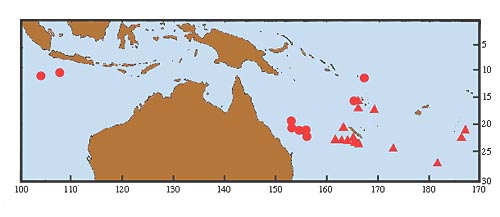Onychoteuthis meridiopacifica
Michael Vecchione, Richard E. Young, Kotaro Tsuchiya, and K.S.R. BolstadIntroduction
O. meridiopacifica may be the smallest species in the genus. Males become mature at 40 mm ML (Rancurel and Okutani, 1990). The short, broad fins and the presence of a few marginal suckers on the tentacular clubs of adults are diagnostic of this species.
Diagnosis
An Onychoteuthis ...
- with ca. 4-6 marginal suckers on tentacular clubs.
- with short, broad fins (length ~35% ML, width 70-80% ML).
- reaching a maximum recorded size of 90 mm ML.
Characteristics
- Tentacular club
- Some proximal marginal suckers remain in adults (3-4 in dorsal series, 1-2 in ventral series).
- Length 20-25% of ML.
- 16-19 hooks (usually 17-18). Examples of club hooks are on the left.
- Carpal locking-apparatus with 6 suckers.
- Terminal pad with "few" suckers.
 Click on an image to view larger version & data in a new window
Click on an image to view larger version & data in a new window



Figure. Oral views of tentacular clubs of O. meridiopacifica. Top - holotype. Drawing from Kubodera et al. (1998). Middle - Drawing from Rancurel 1970, with separate hooks from the ventral (top) and dorsal series. Bottom - Drawing from Rancurel and Okutani 1990.
- Photophores
- Visceral photophores very small.
- Anterior intestinal photophore small, oval; posterior photophore 1.5 times "larger"; does not exceed width of intestine. Intestine not coiled around posterior photophore.
 Click on an image to view larger version & data in a new window
Click on an image to view larger version & data in a new window
Figure. Ventral view of the viscera of O. meridiopacifica showing intestinal photophores. AP - Anterior intestinal photophore. PP - Posterior intestinal photophore. Note the large penis in this mature male. Drawing from Rancurel and Okutani (1990).
Comments
This description is from Rancurel (1970) and Rancurel and Okutani (1990).Life History
A few growth stages were illustrated by Rancurel (1970).

Figure. Growth stages of O. meridiopacifica. A - Dorsal view, 21 mm ML. B - Dorsal view of squid, ventral view of mantle and fins, 57 mm ML. C - Outline drawings of dorsal mantle and fins of squid of various sizes. Drawings from Rancurel (1970).
Distribution
The type locality is 21°15'S, 155°11.5'E, Coral Sea, South Pacific. The known distribution is seen in the map below.
.References
Kubodera, T., U. Piakowski, T. Okutani and M. R. Clarke. 1998 Taxonomy and zoogeography of the family Onychoteuthidae. Smiths. Contr. to Zoology, No. 585: 277-291.
Rancurel, P. 1970. Les contenus stomacuax d’Alepisaurus ferox dans le Sud-ouest Pacifique (cephalopodes). Cah. O.R.S.T.O.M., ser. Oceanogr., 8: 3-87.
Rancurel, P. and T. Okutani. 1990. A new species of squid genus Onychoteuthis from the Southwest Pacific. Venus, 49: 25-30.
Title Illustrations

| Scientific Name | Onychoteuthis meridiopacifica |
|---|---|
| Location | Australia |
| Specimen Condition | Preserved |
| Sex | Male |
| Life Cycle Stage | Mature |
| View | Dorsolateral |
| Size | 59mm ML |
| Copyright |
© 2007 K.S.R. Bolstad

|
| Scientific Name | Onychoteuthis meridiopacifica |
|---|---|
| Location | 21°15'S, 155°12'E |
| Reference | Kubodera, T., U. Piakowski, T. Okutani and M. R. Clarke. 1998 Taxonomy and zoogeography of the family Onychoteuthidae. Smiths. Contr. to Zoology, No. 585: 277-291. |
| Specimen Condition | Dead Specimen |
| View | Ventral |
| Size | 61.7 mm ML |
About This Page

National Museum of Natural History, Washington, D. C. , USA

University of Hawaii, Honolulu, HI, USA

Tokyo University of Fisheries, Tokyo, Japan
K.S.R. Bolstad

Auckland University of Technology
Correspondence regarding this page should be directed to K.S.R. Bolstad at
Page copyright © 2019 , , , and K.S.R. Bolstad
 Page: Tree of Life
Onychoteuthis meridiopacifica .
Authored by
Michael Vecchione, Richard E. Young, Kotaro Tsuchiya, and K.S.R. Bolstad.
The TEXT of this page is licensed under the
Creative Commons Attribution-NonCommercial License - Version 3.0. Note that images and other media
featured on this page are each governed by their own license, and they may or may not be available
for reuse. Click on an image or a media link to access the media data window, which provides the
relevant licensing information. For the general terms and conditions of ToL material reuse and
redistribution, please see the Tree of Life Copyright
Policies.
Page: Tree of Life
Onychoteuthis meridiopacifica .
Authored by
Michael Vecchione, Richard E. Young, Kotaro Tsuchiya, and K.S.R. Bolstad.
The TEXT of this page is licensed under the
Creative Commons Attribution-NonCommercial License - Version 3.0. Note that images and other media
featured on this page are each governed by their own license, and they may or may not be available
for reuse. Click on an image or a media link to access the media data window, which provides the
relevant licensing information. For the general terms and conditions of ToL material reuse and
redistribution, please see the Tree of Life Copyright
Policies.
- First online 23 June 2003
- Content changed 30 May 2008
Citing this page:
Vecchione, Michael, Richard E. Young, Kotaro Tsuchiya, and K.S.R. Bolstad. 2008. Onychoteuthis meridiopacifica . Version 30 May 2008 (under construction). http://tolweb.org/Onychoteuthis_meridiopacifica/19965/2008.05.30 in The Tree of Life Web Project, http://tolweb.org/













 Go to quick links
Go to quick search
Go to navigation for this section of the ToL site
Go to detailed links for the ToL site
Go to quick links
Go to quick search
Go to navigation for this section of the ToL site
Go to detailed links for the ToL site